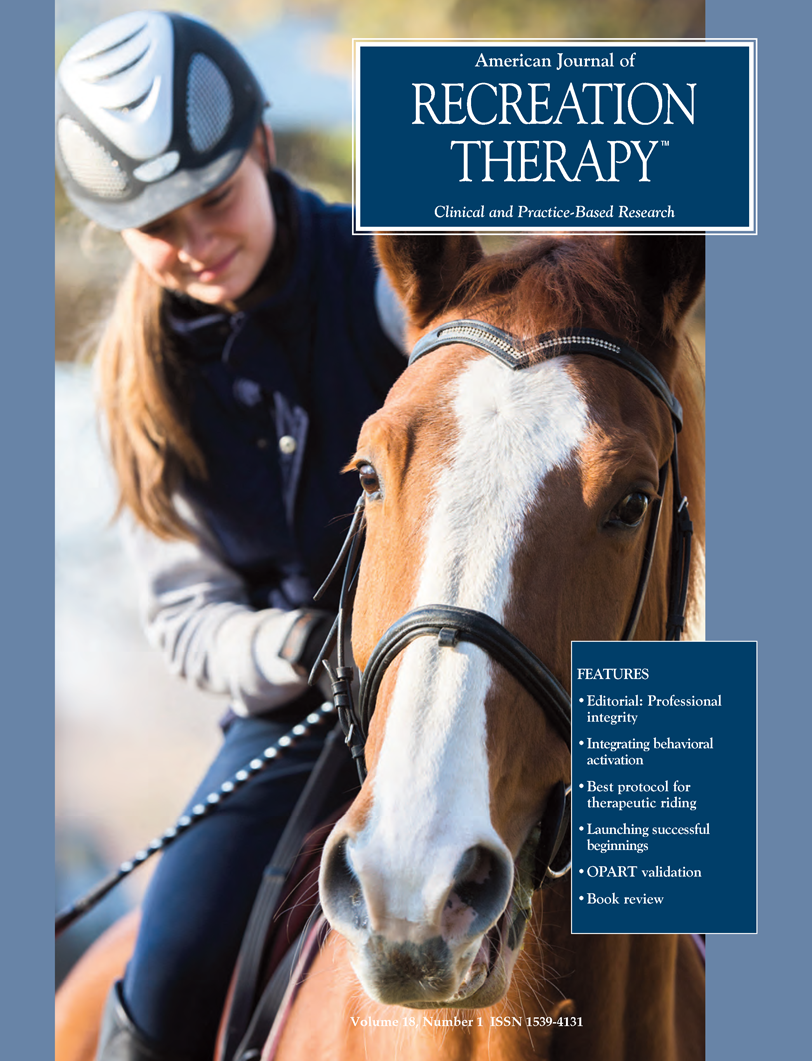Integrating behavioral activation with humanistic psychology and positive psychology: Applications within the health protection/health promotion model
DOI:
https://doi.org/10.5055/ajrt.2019.0177Keywords:
behavioral activation, humanistic psychology, Health Protection, Health Promotion Model, positive psychologyAbstract
Conceptual models for recreational therapy (RT) provide a needed theory-base for practitioners. RT has embraced theoretical concepts from humanistic psychology and positive psychology. Behavior activation offers an additional theoretical perspective for RT by joining with humanistic psychology and positive psychology to form a theory-base for RT. In this article, humanistic psychology and positive psychology are reviewed, behavioral activation is introduced, and it is explained how these three theoretical frameworks have been integrated as theoretical anchors for the author’s conceptual model, the Health Protection/ Health Promotion Model.
References
Austin DR: The changing contextualization of therapeutic recreation: A 40-year perspective. Annu Ther Recreat. 2005; 14: 1-11.
Austin DR: Therapeutic Recreation Processes and Techniques: Evidence-Based Recreational Therapy. 8th ed. Urbana, IL: Sagamore/Venture Publishing, 2018.
Kunstler R, Staveola Daly F: Therapeutic Recreation Leadership and Programming. Champaign, IL: Human Kinetics, 2010.
Austin DR, McCormick BP, Van Puymbroeck M: Positive psychology: A theoretical foundation for recreation therapy practice. Am J Recreat Ther. 2010; 9(2): 17-24.
Austin DR: Therapeutic Recreation Processes and Techniques. 2nd ed. Urbana, IL: Sagamore, 1991.
Austin DR: The Health Protection/Health Promotion Model. Ther Recreat J. 1998; 32(2): 109-117.
Austin DR: Reformulation of the Health Protection/Health Promotion Model. Am J Recreat Ther. 2011; 10(3): 19-26.
Schultz D: Growth Psychology: Models of Healthy Personality. New York, NY: D. Van Nostrand, 1977.
Frye V, Peters M: Therapeutic Recreation: Its Theory, Philosophy, and Practice. Harrisburg, PA: Stackpole Books, 1972: 41.
Austin DR, Crawford ME: Therapeutic Recreation: An Introduction. Englewood Cliffs, NJ: Prentice-Hall, Inc., 1991.
Bullock CC, Mahon MJ: Introduction to Recreation Services for People with Disabilities: A Person-Centered Approach. Champaign, IL: Sagamore Publishing, 1997.
Joseph S, Linley PA: Positive therapy: A positive psychology theory of therapeutic practice. In Linley PA, Joseph S (eds.): Positive Psychology in Practice. Hoboken, NJ: John Wiley & Sons, Inc., 2004: 354-368.
Linley PA, Joseph S: Applied positive psychology: A new perspective for professional practice. In Linley PA, Joseph S (eds.): Positive Psychology in Practice. Hoboken, NJ: John Wiley & Sons, Inc., 2004: 3-14.
Fredrickson BL: The role of positive emotions in positive psychology: The broaden-and-build theory of positive emotion. Am Psychol. 2001; 56: 218-226.
Fredrickson BL: Positivity. New York: Three Rivers Press, 2009.
Austin DR: Implications from the broaden-and-build theory for recreational therapy. Am J Recreat Ther. 2017; 16(1): 6-7.
Austin DR, McCormick BP: The truth about strengths-based practice: Not a new paradigm for recreational therapy—But an important one. Am J Recreat Ther. 2016; 15(3): 19-28.
Austin DR: The strengths-based approach in recreational therapy. In Austin DR, McCormick BP (eds.): Perspectives on Recreational Therapy. Urbana, IL: Sagamore/Venture, 2017: 155-179.
Chartier IS, Provencher MD: Behavioural activation for depression: Efficacy, effectiveness and dissemination. J Affect Disord. 2013; 145: 292-299.
Dimidjian S, Barrera M, Martell C, et al.: The origins and current status of behavioral activation treatments of depression. Annu Rev Clin Psychol. 2011; 7: 1-38.
Kanter JW, Busch AM, Rusch LC: Behavioral Activation: Distinctive Features. New York, NY: Routledge, 2009.
Kanter JW, Manos RC, Bowe WM, et al.: What is behavioral activation? A review of the empirical literature. Clin Psychol Rev. 2010; 30: 608-620.
Hale A, Spates CR: Behavioral activation: Only an intervention for treating depression, or an approach for achieving a meaningful life? Ann Psychother. 2015. Available at http://www.annalsofpsychotherapy.com/articles/2015/PDF/Hale_Spates_450.pdf. Accessed September 9, 2018.
Lewis ST: Major depressive disorder. In Porter HR (ed.): Recreational Therapy for Specific Diagnoses and Conditions. Enumclaw, WA: Idyll Arbor, Inc., 2015: 215-225.
Martell CR, Dimidjian S, Herman-Dunn R: Behavioral Activation for Depression: A Clinician’s Guide. New York: The Guilford Press, 2014.
Austin DR: Conceptual models for theory and practice. In Austin DR, McCormick BP (eds.): Perspectives on Recreational Therapy. Urbana, IL: Sagamore/Venture, 2017: 155-179.
Fawcett J: Guest editorial: On bed baths and conceptual models of nursing. J Adv Nurs. 2003; 44(1): 229-230.
Flynn PAR: Holistic Health: The Art and Science of Care. Bowie, MD: Robert J. Brady Co., 1980.
Beck JS: Cognitive Behavior Therapy: Basics and Beyond. 2nd ed. New York: Guilford Press, 2011.
Fawcett J: A framework for analysis and evaluation of conceptual models of nursing. Nurse Educ. 1980; 5(6): 10-14.
Dieser RB, Chistenson J: Integrating positive psychology, behavioral activation, and the serious leisure perspective in mental health counseling: A case report. Int J Appl Positive Psychol. 2016; 1: 57-68.
Published
How to Cite
Issue
Section
License
Copyright 2000-2025, Weston Medical Publishing, LLC and American Journal of Recreation Therapy. All Rights Reserved.


